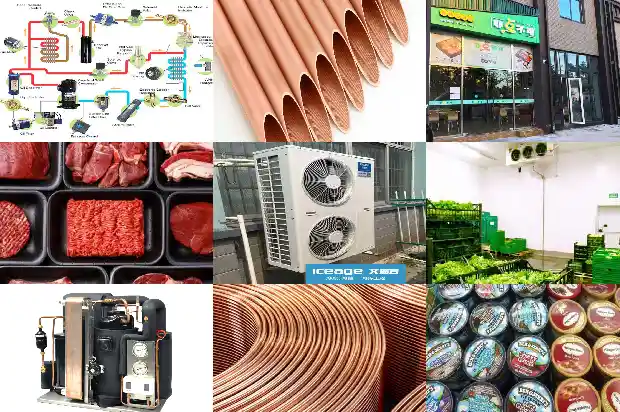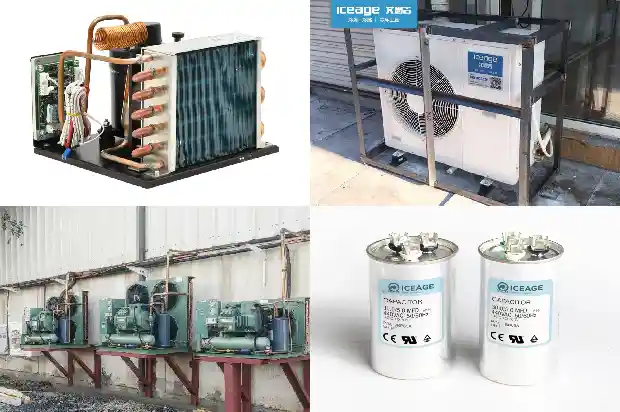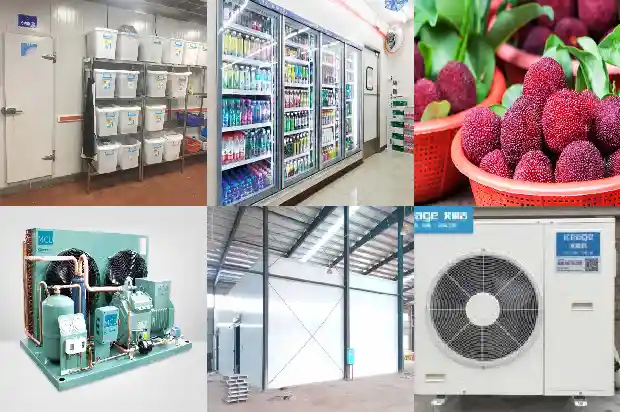Common Fault Causes of Totally Enclosed Refrigeration Compressors
2025-03-01
- How to identify the 3 terminals on the casing of a totally enclosed compressor?
The running terminal (R), the starting terminal (S), and the common terminal (C). The resistance between RS is greater than the resistance between SC, which is greater than the resistance between RC. The resistance between RS is equal to the sum of the resistance between SC and the resistance between RC. The above rules can be used for identification.
It should be noted that the resistance values of the terminal connections of a three-phase compressor are equal.
- How to determine if the winding of the compressor motor is short-circuited?
Select the resistance range of a multimeter, and after zero adjustment, measure the resistance values between two points C - R or C - S of the compressor motor winding. If the measured resistance value of the winding is less than the normal value, it can be determined that this winding is short-circuited.
2.1 Three-phase compressor:
2.1.1 If the resistance values measured twice are infinite, it indicates that one set of windings is open-circuited.
2.1.2 If the resistance values measured three times are all infinite, it indicates that at least two sets of windings are open-circuited.
2.1.3 If the resistance values measured twice are significantly smaller than the value measured in the other test among the three measurements, it indicates a short circuit. - How to determine if the compressor motor touches the casing and is grounded?
Use the resistance range of a multimeter. Then, firmly press one probe against the common point, and press the other probe against the exposed metal part on the process tube of the compressor, or remove a small piece of the paint on the outer shell plate for measurement. If the resistance value is very small, it can be determined that the winding or the internal wiring touches the casing and is grounded. - How to determine if the winding of the compressor motor is open-circuited?
Adjust the multimeter to the resistance range, and connect the probes to the connection terminals of any 2 windings to measure their resistance values. If the winding value is infinite, that is, there is no conduction between the connection terminals of the 2 windings, it can be determined that this winding is open-circuited. - What should be checked when the compressor does not start?
5.
1 Check whether the compressor overload protector, pressure switch, and overcurrent protector are tripped or damaged.
5.2 Check whether the indoor temperature sensor and the pipe temperature sensor are open-circuited or have poor contact. In the heating mode, check whether they are short-circuited.
5.3 Check whether the relay is engaged, whether the compressor is open-circuited or short-circuited, and whether the compressor capacitor is damaged. - What are the reasons for the compressor to overheat and stop soon after starting?
6.1 Insufficient or excessive refrigerant, blockage of the capillary assembly, and internal leakage of the four-way valve.
6.2 Faults of the compressor itself, such as short circuit, open circuit, and touching the casing and being grounded, etc.
6.3 Excessively high high-pressure, and the pressure relay operates.
6.4 Poor ventilation of the condenser or air flow short circuit, or the system is mixed with non-condensable liquid gas.
6.5 Excessively high ambient temperature of the outdoor unit.
6.6 The compressor is stuck in the cylinder or seized on the shaft. - Manifestations of low compressor efficiency
Generally, it is manifested as a decrease in the discharge pressure, an increase in the suction pressure, and excessively high temperatures of the compressor cylinder head and the suction and discharge chambers.
- Judgment of the compressor losing its working ability
First, test whether there is suction at the suction port, and then test whether there is exhaust at the discharge port. Block the discharge port with your hand. If you feel that the pressure is not very high, or there is even no exhaust, it can be considered that the compressor has lost its working ability. - Why is the current of the compressor motor too large?
There is a short circuit between the turns of the compressor, but it has not reached the extent of blowing the fuse. The "secondary friction" of the compressor damages the smoothness of the friction surface, resulting in an increase in the power and current of the compressor, but it has not reached the extent of "seizing the shaft" or "sticking the cylinder" that makes the compressor unable to rotate. Use a multimeter to check the insulation resistance of the compressor to the ground. Under normal circumstances, it should be above 2MΩ. If it becomes smaller or approaches zero, it indicates a short circuit. If the insulation resistance to the ground is normal, check the resistance values of the starting and running windings. If there is a short circuit between the turns, the running current will increase. - What are the reasons for the difficult starting of a three-phase compressor motor?
10.1 The power supply voltage is too low, and there is a short circuit in the winding of the compressor motor. - How to troubleshoot the faults of a three-phase compressor motor, such as a slow running speed, a blown fuse of one phase, and an increased current of one phase during operation?
11.1 It is often caused by one phase of the compressor motor winding touching the casing and being grounded. After removing the grounding wire, you can use a test pencil to check whether the casing is electrified. If the casing is electrified, rewind the compressor motor winding or replace the compressor. - How to troubleshoot the "keng keng" sound emitted by a three-phase compressor motor during operation?
12.1 The "keng keng" sound emitted by a three-phase compressor motor during operation is caused by a serious imbalance of the three phases, with one phase of the power supply lacking. Restoring the three phases can solve the problem. - How to troubleshoot the reverse rotation of a three-phase compressor motor?
13.1 It is caused by incorrect wiring. Just swap any two of the three phases. - Compressor replacement sequence and precautions
14.1 R22 is a non-flammable gas. However, if it comes into direct contact with a high-temperature flame, toxic gas will be generated. Therefore, before welding operations, release the refrigerant in the refrigeration system.
14.2 R32 is a flammable and explosive refrigerant. For any R32 refrigeration equipment that requires the replacement of components during the maintenance of the refrigeration system, vacuuming must be carried out before the operation! Pay attention not to introduce a fire source!
14.3 R410A is low-toxic, non-flammable, and non-explosive. When replacing the compressor, a compressor using R410A must be used, and an R22 compressor must never be installed. When replacing the valve parts, there are special markings on the valve body of R410A. - What types of overload protectors are there for the compressor of an air conditioner?
15.1 External overload protector; Embedded overload protector. - What are the protections for the compressor?
16.1 Overload protector: It is mainly used for overcurrent and overheat protection of the compressor motor.
16.2 Internal protector: It is mainly used for overcurrent protection of the compressor motor.
16.3 Thermal relay: It is mainly used for overcurrent protection of the circuit of a three-phase compressor motor.
16.4 Reverse phase preventer: It is mainly used for three-phase rotary compressors to prevent the reverse rotation or phase loss of the compressor. - What are the common reasons for the operation of the overload protector?
17.1 The power supply voltage is too low, and the symmetry of the three-phase voltage is poor.
17.2 The compressor motor runs at a low speed for an extended period.
17.3 The compressor motor runs under load at a low voltage for a long time.
17.4 The cooling medium path of the compressor motor is blocked.
17.5 The ambient temperature of use is too high. - What is the liquid slugging of the compressor?
18.1 The refrigerant is not completely evaporated in the evaporator, resulting in the compressor sucking back the refrigerant as wet vapor or liquid, causing liquid slugging of the compressor.
18.2 Liquid slugging can cause damage to the valve plate, valve seat, and piston. In severe cases, the connecting rod may also be deformed, and even the compressor may be damaged.
Related Articles
- Common Fault Causes and Replacement of Multi-connected Unit Compressors
- How to Inspect and Troubleshoot the Faults of the Control Valve in the Cold Storage?
- Common Faults in Refrigeration Systems and Handling Methods
- What Are the Common Causes of High - pressure Faults in Chillers?
- Basic Faults and Preventive Maintenance of Water - cooled Units
- Composition and Common Faults of Screw Refrigeration Compressors
- Common Faults and Solutions of Central Air - conditioning Chiller Units
- Common Faults of Industrial Chillers
- Common Faults and Corresponding Solutions of Chillers During Use
- Analysis and Troubleshooting of Common Faults in Air - source Heat Pumps
- Maintenance Methods for Faults in Screw Refrigeration Air - conditioner Compressors
- Common Faults and Troubleshooting Methods of the Moving Mechanism of Piston Compressors
- Analysis of Common Faults in Compressor Overcurrent and Burnout
- What are the reasons for the inactivity of the automotive air conditioning compressor? What are the common faults?
- Common Faults of HVAC Fan Coil Units
- Common Fault Repair of Frozen Cold Storage
- Common Operating Faults and Treatment Methods of Centrifugal Compressors
- Common Four Faults and Replacement Methods of Scroll Compressor
